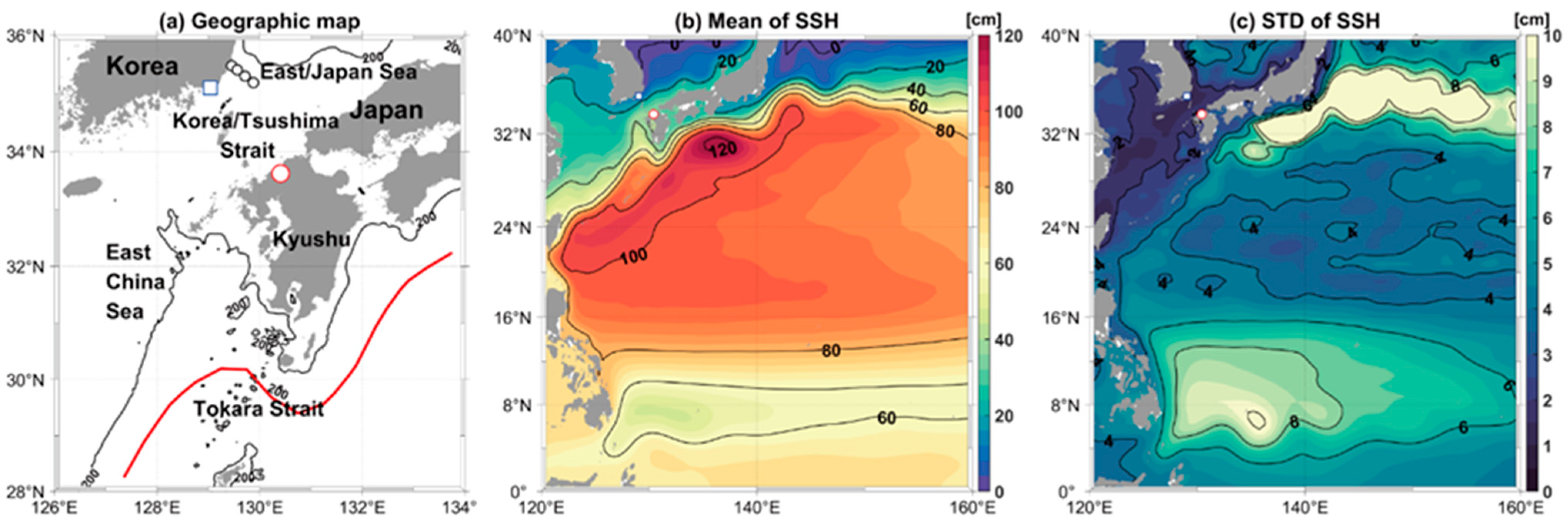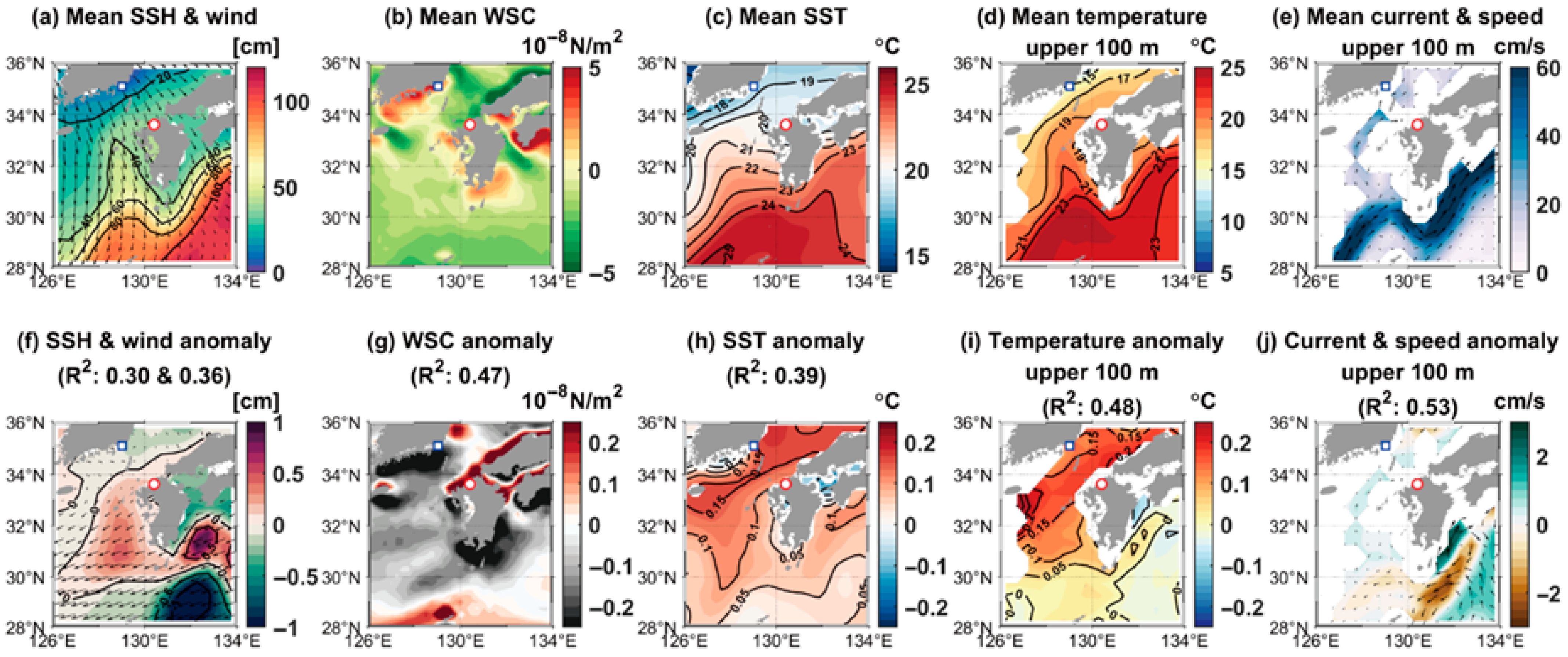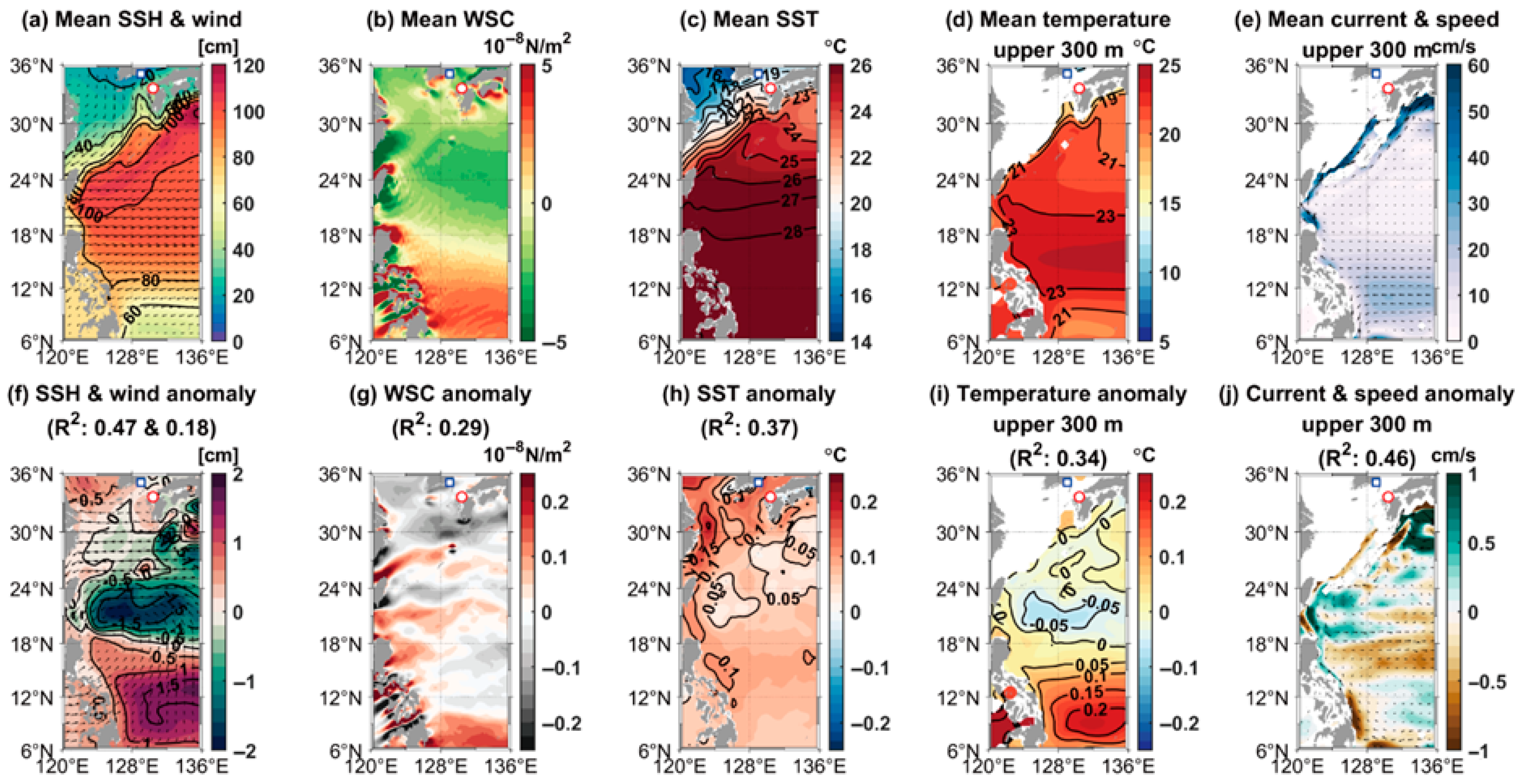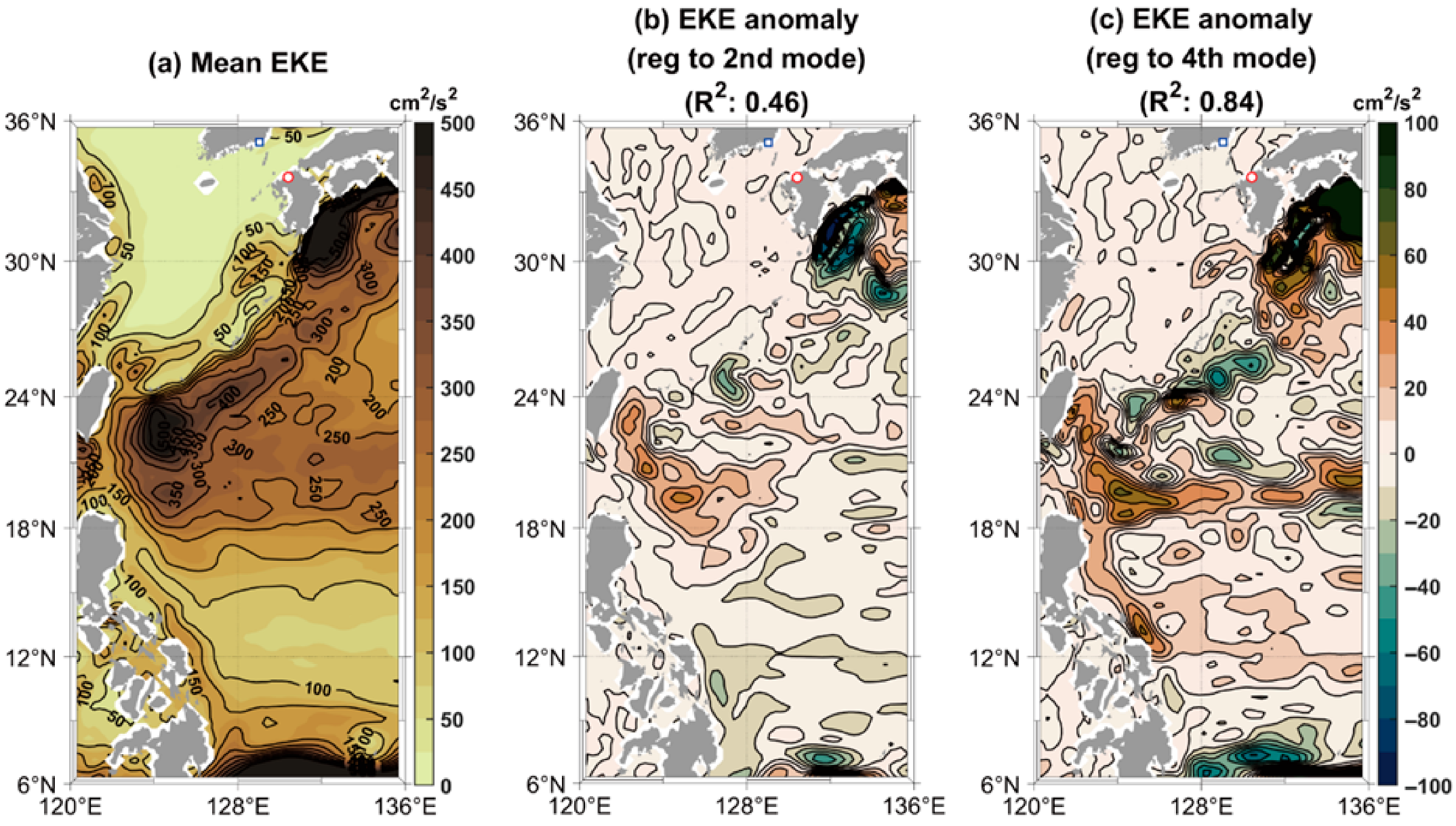Interannual Variability in Barotropic Sea Level Differences Across the Korea/Tsushima Strait and Its Relationship to Upper-Ocean Current Variability in the Western North Pacific
Abstract
1. Introduction
2. Data and Methods
2.1. Data
2.2. The Calculation of the Barotropic Sea Level Difference Across the KTS
2.3. Cyclostationary Empirical Orthogonal Function and Regression Analysis
3. Results
3.1. Sea Level Differences Across the KTS
3.2. Inflow Through the KTS and Ocean Environment Around the KTS
3.3. The Inflow Through the KTS and Ocean Environment in the Wider Domain of the Western North Pacific
3.4. The Inflow Through the KTS and Upper-Ocean Currents in the Western North Pacific
4. Discussion
Limitations and Future Directions
5. Summary and Concluding Remarks
- 1.
- An increase in the KTS inflow is associated with a La Niña-like state in the western North Pacific, involving a weaker Kuroshio current and an equatorward shift in the NPSG.
- 2.
- The variability in KTS inflow is linked to at least two statistically distinct modes of upper-ocean current variability. These modes are linearly uncorrelated in the contemporaneous analysis, with one clearly tied to ENSO and the other associated with relatively regional EKE, suggesting the presence of multiple forcing pathways.
- 3.
- The identification of these parallel pathways suggests that both large-scale climate forcing and internal oceanic dynamics contribute to modulating the KTS inflow. The modest explanatory power of each individual pathway underscores the inherent complexity of the system.
Supplementary Materials
Author Contributions
Funding
Data Availability Statement
Acknowledgments
Conflicts of Interest
References
- Nitani, H. Beginning of the Kuroshio. Kuroshio: Its Physical Aspects; University of Tokyo Press: Tokyo, Japan, 1972; pp. 129–163. [Google Scholar]
- Cho, Y.-K.; Kim, K. Structure of the Korea Strait Bottom Cold Water and its seasonal variation in 1991. Cont. Shelf Res. 1998, 18, 791–804. [Google Scholar] [CrossRef]
- Lie, H.J.; Cho, C.H.; Lee, J.H.; Niiler, P.; Hu, J.H. Separation of the Kuroshio water and its penetration onto the continental shelf west of Kyushu. J. Geophys. Res. Oceans 1998, 103, 2963–2976. [Google Scholar] [CrossRef]
- Guo, X.; Miyazawa, Y.; Yamagata, T. The Kuroshio onshore intrusion along the shelf break of the East China Sea: The origin of the Tsushima Warm Current. J. Phys. Oceanogr. 2006, 36, 2205–2231. [Google Scholar] [CrossRef]
- Minato, S.; Kimura, R. Volume transport of the western boundary current penetrating into a marginal sea. J. Oceanogr. Soc. Jpn. 1980, 36, 185–195. [Google Scholar] [CrossRef]
- Isobe, A.; Ando, M.; Watanabe, T.; Senjyu, T.; Sugihara, S.; Manda, A. Freshwater and temperature transports through the Tsushima-Korea Straits. J. Geophys. Res. Oceans 2002, 107, 2-1–2-20. [Google Scholar] [CrossRef]
- Na, H.; Kim, K.Y.; Chang, K.I.; Park, J.J.; Kim, K.; Minobe, S. Decadal variability of the upper ocean heat content in the East/Japan Sea and its possible relationship to northwestern Pacific variability. J. Geophys. Res. Oceans 2012, 117, C02017. [Google Scholar] [CrossRef]
- Teague, W.J.; Hwang, P.A.; Jacobs, G.A.; Book, J.W.; Perkins, H.T. Transport variability across the Korea/Tsushima Strait and the Tsushima Island wake. Deep Sea Res. Part II 2005, 52, 1784–1801. [Google Scholar] [CrossRef]
- Tsujino, H.; Nakano, H.; Motoi, T. Mechanism of currents through the straits of the Japan Sea: Mean state and seasonal variation. J. Oceanogr. 2008, 64, 141–161. [Google Scholar] [CrossRef]
- Kida, S.; Takayama, K.; Sasaki, Y.N.; Matsuura, H.; Hirose, N. Increasing trend in japan sea throughflow transport. J. Oceanogr. 2021, 77, 145–153. [Google Scholar] [CrossRef]
- Shin, H.-R.; Lee, J.-H.; Kim, C.-H.; Yoon, J.-H.; Hirose, N.; Takikawa, T.; Cho, K. Long-term variation in volume transport of the Tsushima warm current estimated from ADCP current measurement and sea level differences in the Korea/Tsushima Strait. J. Mar. Syst. 2022, 232, 103750. [Google Scholar] [CrossRef]
- Teague, W.J.; Jacobs, G.A.; Ko, D.S.; Tang, T.Y.; Chang, K.I.; Suk, M.S. Connectivity of the Taiwan, Cheju, and Korea straits. Cont. Shelf Res. 2003, 23, 63–77. [Google Scholar] [CrossRef]
- Isobe, A. Recent advances in ocean-circulation research on the Yellow Sea and East China Sea shelves. J. Oceanogr. 2008, 64, 569–584. [Google Scholar] [CrossRef]
- Cho, Y.-K.; Seo, G.-H.; Kim, C.-S.; Choi, B.-J.; Shaha, D.C. Role of wind stress in causing maximum transport through the Korea Strait in autumn. J. Mar. Syst. 2013, 115, 33–39. [Google Scholar] [CrossRef]
- Gordon, A.L.; Giulivi, C.F. Pacific decadal oscillation and sea level in the Japan/East Sea. Deep Sea Res. Part I 2004, 51, 653–663. [Google Scholar] [CrossRef]
- Toole, J.; Zou, E.; Millard, R. On the circulation of the upper waters in the western equatorial Pacific Ocean. Deep Sea Res. Part I 1988, 35, 1451–1482. [Google Scholar] [CrossRef]
- Qiu, B.; Lukas, R. Seasonal and interannual variability of the North Equatorial Current, the Mindanao Current, and the Kuroshio along the Pacific western boundary. J. Geophys. Res. Oceans 1996, 101, 12315–12330. [Google Scholar] [CrossRef]
- Kim, Y.Y.; Qu, T.; Jensen, T.; Miyama, T.; Mitsudera, H.; Kang, H.W.; Ishida, A. Seasonal and interannual variations of the North Equatorial Current bifurcation in a high-resolution OGCM. J. Geophys. Res. Oceans 2004, 109, C03040. [Google Scholar] [CrossRef]
- Qiu, B.; Chen, S. Multidecadal sea level and gyre circulation variability in the northwestern tropical Pacific Ocean. J. Phys. Oceanogr. 2012, 42, 193–206. [Google Scholar] [CrossRef]
- Qu, T. Depth distribution of the subtropical gyre in the North Pacific. J. Oceanogr. 2002, 58, 525–529. [Google Scholar] [CrossRef]
- Qu, T.; Lukas, R. The bifurcation of the North Equatorial Current in the Pacific. J. Phys. Oceanogr. 2003, 33, 5–18. [Google Scholar] [CrossRef]
- Qiu, B.; Chen, S.; Klein, P.; Sasaki, H.; Sasai, Y. Seasonal mesoscale and submesoscale eddy variability along the North Pacific Subtropical Countercurrent. J. Phys. Oceanogr. 2014, 44, 3079–3098. [Google Scholar] [CrossRef]
- Zhang, X.; Cornuelle, B.; Roemmich, D. Sensitivity of western boundary transport at the mean North Equatorial Current bifurcation latitude to wind forcing. J. Phys. Oceanogr. 2012, 42, 2056–2072. [Google Scholar] [CrossRef]
- Guo, H.; Chen, Z.; Yang, H. Poleward shift of the Pacific north equatorial current bifurcation. J. Geophys. Res. Oceans 2019, 124, 4557–4571. [Google Scholar] [CrossRef]
- Qiu, B.; Chen, S. Interannual-to-decadal variability in the bifurcation of the North Equatorial Current off the Philippines. J. Phys. Oceanogr. 2010, 40, 2525–2538. [Google Scholar] [CrossRef]
- Wang, Y.L.; Wu, C.R.; Chao, S.Y. Warming and weakening trends of the Kuroshio during 1993–2013. Geophys. Res. Lett. 2016, 43, 9200–9207. [Google Scholar] [CrossRef]
- Zhang, Y.; Zhang, Z.; Chen, D.; Qiu, B.; Wang, W. Strengthening of the Kuroshio current by intensifying tropical cyclones. Science 2020, 368, 988–993. [Google Scholar] [CrossRef]
- Chang, Y.L.; Oey, L.Y. Interannual and seasonal variations of Kuroshio transport east of Taiwan inferred from 29 years of tide-gauge data. Geophys. Res. Lett. 2011, 38, L08603. [Google Scholar] [CrossRef]
- Hsin, Y.C.; Qiu, B.; Chiang, T.L.; Wu, C.R. Seasonal to interannual variations in the intensity and central position of the surface Kuroshio east of Taiwan. J. Geophys. Res. Oceans 2013, 118, 4305–4316. [Google Scholar] [CrossRef]
- Tsujino, H.; Nishikawa, S.; Sakamoto, K.; Usui, N.; Nakano, H.; Yamanaka, G. Effects of large-scale wind on the Kuroshio path south of Japan in a 60-year historical OGCM simulation. Clim. Dyn. 2013, 41, 2287–2318. [Google Scholar] [CrossRef]
- Soeyanto, E.; Guo, X.; Ono, J.; Miyazawa, Y. Interannual variations of Kuroshio transport in the East China Sea and its relation to the Pacific Decadal Oscillation and mesoscale eddies. J. Geophys. Res. Oceans 2014, 119, 3595–3616. [Google Scholar] [CrossRef]
- Lyu, S.J.; Kim, K. Absolute transport from the sea level difference across the Korea Strait. Geophys. Res. Lett. 2003, 30, 1285. [Google Scholar] [CrossRef]
- Woodworth, P.; Player, R. The permanent service for mean sea level: An update to the 21stCentury. J. Coast. Res. 2003, 19, 287–295. [Google Scholar]
- Mizuno, S.; Kawatate, K.; Nagahama, T.; Miita, T. Measurements of East Tushima Current in winter and estimation of its seasonal variability. J. Oceanogr. Soc. Jpn. 1989, 45, 375–384. [Google Scholar] [CrossRef]
- Isobe, A. Seasonal variability of the barotropic and baroclinic motion in the Tsushima-Korea Strait. J. Oceanogr. 1994, 50, 223–238. [Google Scholar] [CrossRef]
- Carton, J.A.; Chepurin, G.A.; Chen, L. SODA3: A new ocean climate reanalysis. J. Clim. 2018, 31, 6967–6983. [Google Scholar] [CrossRef]
- Ducet, N.; Le Traon, P.-Y.; Reverdin, G. Global high-resolution mapping of ocean circulation from TOPEX/Poseidon and ERS-1 and-2. J. Geophys. Res. Oceans 2000, 105, 19477–19498. [Google Scholar] [CrossRef]
- Hersbach, H.; Bell, B.; Berrisford, P.; Hirahara, S.; Horányi, A.; Muñoz-Sabater, J.; Nicolas, J.; Peubey, C.; Radu, R.; Schepers, D. The ERA5 global reanalysis. Q. J. R. Meteorolog. Soc. 2020, 146, 1999–2049. [Google Scholar] [CrossRef]
- Huang, B.; Menne, M.J.; Boyer, T.; Freeman, E.; Gleason, B.E.; Lawrimore, J.H.; Liu, C.; Rennie, J.J.; Schreck III, C.J.; Sun, F. Uncertainty estimates for sea surface temperature and land surface air temperature in NOAAGlobalTemp version 5. J. Clim. 2020, 33, 1351–1379. [Google Scholar] [CrossRef]
- Garrett, C.; Petrie, B. Dynamical aspects of the flow through the Strait of Belle Isle. J. Phys. Oceanogr. 1981, 11, 376–393. [Google Scholar] [CrossRef]
- Yang, Y.; Liu, C.T.; Lee, T.N.; Johns, W.; Li, H.W.; Koga, M. Sea surface slope as an estimator of the Kuroshio volume transport east of Taiwan. Geophys. Res. Lett. 2001, 28, 2461–2464. [Google Scholar] [CrossRef]
- Fofonoff, N. Machine computations of mass transport in the North Pacific Ocean. J. Fish. Res. Board Can. 1962, 19, 1121–1141. [Google Scholar] [CrossRef]
- Kim, K.-Y.; North, G.R.; Huang, J. EOFs of one-dimensional cyclostationary time series: Computations, examples, and stochastic modeling. J. Atmos. Sci. 1996, 53, 1007–1017. [Google Scholar] [CrossRef]
- Kim, K.-Y.; North, G.R. EOFs of harmonizable cyclostationary processes. J. Atmos. Sci. 1997, 54, 2416–2427. [Google Scholar] [CrossRef]
- Kim, K.-Y.; Hamlington, B.; Na, H. Theoretical foundation of cyclostationary EOF analysis for geophysical and climatic variables: Concepts and examples. Earth Sci. Rev. 2015, 150, 201–218. [Google Scholar] [CrossRef]
- Kim, J.; Na, H. Interannual Variability of Yellowfin Tuna (Thunnus albacares) and Bigeye Tuna (Thunnus obesus) Catches in the Southwestern Tropical Indian Ocean and Its Relationship to Climate Variability. Front. Mar. Sci. 2022, 9, 857405. [Google Scholar] [CrossRef]
- Fukudome, K.-I.; Yoon, J.-H.; Ostrovskii, A.; Takikawa, T.; Han, I.-S. Seasonal volume transport variation in the Tsushima Warm Current through the Tsushima Straits from 10 years of ADCP observations. J. Oceanogr. 2010, 66, 539–551. [Google Scholar] [CrossRef]
- Andres, M.; Gawarkiewicz, G.; Toole, J. Interannual sea level variability in the western North Atlantic: Regional forcing and remote response. Geophys. Res. Lett. 2013, 40, 5915–5919. [Google Scholar] [CrossRef]
- Liu, Z.J.; Zhu, X.H.; Nakamura, H.; Nishina, A.; Wang, M.; Zheng, H. Comprehensive observational features for the Kuroshio transport decreasing trend during a recent global warming hiatus. Geophys. Res. Lett. 2021, 48, e2021GL094169. [Google Scholar] [CrossRef]
- Chen, Z.; Wu, L. Long-term change of the Pacific North Equatorial Current bifurcation in SODA. J. Geophys. Res. Oceans 2012, 117, C06016. [Google Scholar] [CrossRef]
- Wu, C.R.; Hsin, Y.C.; Chiang, T.L.; Lin, Y.F.; Tsui, I.F. Seasonal and interannual changes of the Kuroshio intrusion onto the East China Sea Shelf. J. Geophys. Res. Oceans 2014, 119, 5039–5051. [Google Scholar] [CrossRef]
- Qiu, B.; Chen, S. Interannual variability of the North Pacific Subtropical Countercurrent and its associated mesoscale eddy field. J. Phys. Oceanogr. 2010, 40, 213–225. [Google Scholar] [CrossRef]






Disclaimer/Publisher’s Note: The statements, opinions and data contained in all publications are solely those of the individual author(s) and contributor(s) and not of MDPI and/or the editor(s). MDPI and/or the editor(s) disclaim responsibility for any injury to people or property resulting from any ideas, methods, instructions or products referred to in the content. |
© 2025 by the authors. Licensee MDPI, Basel, Switzerland. This article is an open access article distributed under the terms and conditions of the Creative Commons Attribution (CC BY) license (https://creativecommons.org/licenses/by/4.0/).
Share and Cite
Kim, J.; Na, H.; Lee, S. Interannual Variability in Barotropic Sea Level Differences Across the Korea/Tsushima Strait and Its Relationship to Upper-Ocean Current Variability in the Western North Pacific. Climate 2025, 13, 144. https://doi.org/10.3390/cli13070144
Kim J, Na H, Lee S. Interannual Variability in Barotropic Sea Level Differences Across the Korea/Tsushima Strait and Its Relationship to Upper-Ocean Current Variability in the Western North Pacific. Climate. 2025; 13(7):144. https://doi.org/10.3390/cli13070144
Chicago/Turabian StyleKim, Jihwan, Hanna Na, and SeungYong Lee. 2025. "Interannual Variability in Barotropic Sea Level Differences Across the Korea/Tsushima Strait and Its Relationship to Upper-Ocean Current Variability in the Western North Pacific" Climate 13, no. 7: 144. https://doi.org/10.3390/cli13070144
APA StyleKim, J., Na, H., & Lee, S. (2025). Interannual Variability in Barotropic Sea Level Differences Across the Korea/Tsushima Strait and Its Relationship to Upper-Ocean Current Variability in the Western North Pacific. Climate, 13(7), 144. https://doi.org/10.3390/cli13070144






